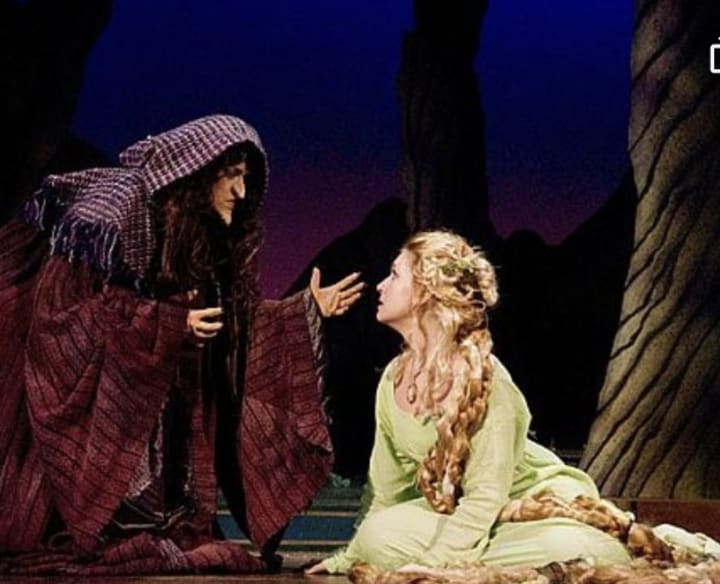Rapunzel Rapunzel let down thy hair
This tale from the Brothers Grimm has an interesting history

Rapunzel is one of my favorite fairy tales. As a little girl, I recall my great grandmother often saying "Rapunzel, Rapunzel, let down thy hair that I may climb without a stair." I visualized what it would be like to have such long thick tresses that an individual could use my hair to climb up a tower. In one book version of the story. I read that the prince said "Rapunzel! Rapunzel! Let down your hair that I may climb thy golden stair". This German fairy tale was recorded by the Brothers Grimm who collected folklore and used their talent to turned what they heard into their own version of the stories.
According to the tale, when Rapunzel’s mother was pregnant she craved rampion, a type of green salad also known as rapunzel that was growing in a neighboring yard. She complained so much about her desire for the greens that her husband went over and got her some. The neighbor who was a witch became furious and said the man should have asked instead of stealing her greens. She demanded their child immediately after she was born she as retribution. Some versions of the story say the witch allowed the little girl to live with her parents for 2 years before claiming her.

There are other tales which say the husband and wife fled from their home and moved away in an attempt tto hide their little girl. The witch, however, located the family and took the child away. The evil woman named the child Rapunzel because of the greens she had eaten and in time the girl grew into a beautiful maiden with long lustrous golden locks.In the storybooks I read there was never mention of the parents again. I always wondered how they lived without doing anything to free their daughter from captivity.
The Grimm siblings first published Rapunzel in 1812 as part of Children's and Household Tales. The Brothers Grimm's story has quite an interesting history as to how it became the beloved tale that is read to children today. Rapunzel is an adaptation of a 1790 Friedrich Schultz fairy tale. Schultz had translated a 1698 Persinette by Charlotte-Rose de Caumont de La Force which she wrote and was influenced byPetrosinella by Giambattista Basile. a 1634 Italian tale.

There are still variations of this fairy tale today but the basic theme remains the same. When the witch saw how beautiful Rapunzel was she built a tower and locked inside. The only intrance was a hug window at the top. The witch entered the tower by calling out the rhyme of “Rapunzel Rapunzel let down thy hair.’’ The teenager’s tresses had grown long and strong and when she heard the witch she let her hair down from the window and the sorceress climbed up. The purpose of the prison was to keep the beautiful girl away from the world, especially men.
One day a handsome prince was going through the woods where the tower had been built. He heard the witch and saw the beautiful maiden let down her hair so the old crone could climb up. Once he witch was gone the prince called for Rupunzel to let down her hair and she did. This has always been my favorite part of the story. The prince climbs up and they instantly fall in love. Rapunzel tells him that he is much better looking than old mother Gothel and although it’s only implied in the children’s tale the two obviously make love.
I’m a romantic and on many occasions I used to envision the couple holding hands, kissing, and giving in to passion. The prince visits Rapunzel often and admonished her to never tell the witch that he knows the secret. He began bringing her strands of silk that she could put together and one fay have enough to climb down from her prison. One day however she slips up by asking Gothel how is it that the prince climbs up to the tower faster than she does. Some versions of the story say that her clothing was too tight which gave away the fact that she was pregnant.

Whatever happened the witch became enraged and cut Rapunzel’s golden hair. She cast her out of the tower to live alone in the wilderness. The witch waited and when she heard the prince call she let down the hair she had cut. She allowed the prince to climb up only so far then dropped him. A thorn bush broke his fall but the broad blinded him. He wandered through the woods and one day found Rapunzel who had given birth to twins. As they hugged and kissed and cried, Rapunzel’s tears fell on her lover’s eyes and his blindness was cured.
As a child this was simply a happily ever after fairy tale but as an adult I see other hidden meanings to the story. The first relates to Rapunzel’s mother who selfishly craved what belonged to another which set this all in motion and deprecated her ftom her daughter for the rest of her life. The second is the father who poroves there are always consequences to our actions that not only hurt us but others as well. This man his wife and daughter all suffered because he did not ask permission for the salad.
The third lesson is that when you try too hard to control the life of others the thing you try to prevent can happen anyway. The witch thought she was keeping Rapunzel from men where there is a will there is a way. The prince found her and she became an unwed mother.I sometimes put all this aside and only focus on the beautiful girl with the long golden tresses who was rescued baby her prince. Fairy tales can be vehicles of escape and a way to hold on to a dream that some unfortunate circumstance will work out.
About the Creator
Cheryl E Preston
Cheryl is a widow who enjoys writing about current events, soap spoilers and baby boomer nostalgia. Tips are greatly appreciated.
Enjoyed the story? Support the Creator.
Subscribe for free to receive all their stories in your feed. You could also pledge your support or give them a one-off tip, letting them know you appreciate their work.






Comments
There are no comments for this story
Be the first to respond and start the conversation.